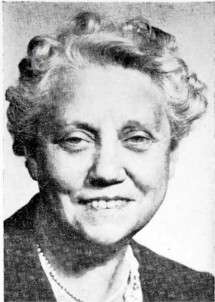Gertrude Lilian Entwisle
Gertrude Lilian Entwisle (12 June 1892 – 18 November 1961) was an electrical engineer. She was the first British woman to retire from a complete career in industry as a professional engineer; the first female engineer to work at British Westinghouse; and the first female student, graduate, and associate member of the Institution of Electrical Engineers (now the Institution of Engineering and Technology).[2][3] Entwisle was known for her work on designing DC motors and exciters. Her obituary said she broke "barriers of prejudice to become a respected designer of electrical rotating machinery."[2]
Gertrude Lilian Entwisle | |
|---|---|
 fair use - no known owner | |
| Born | 12 June 1892 Swinton, Greater Manchester,[1] England |
| Died | 18 November 1961 Sale, Greater Manchester,[1] England |
| Nationality | British |
| Education | University of Manchester |
| Occupation | Electrical engineer |
| Known for | Engineering design |
Early life and education
Entwisle was educated at Manchester High School for Girls and obtained a scholarship to the University of Manchester where she studied from 1911 to 1914. Entwisle originally studied physics including under Ernest Rutherford, but was able to attend engineering classes when they were opened to female students.[1][2] In July 1914, Entwisle failed her preliminary physics examination and left the Victoria University of Manchester without graduating.[1]
Early Career during World War I
In 1915, at the beginning of the World War I, British Westinghouse (later Metropolitan-Vickers) was looking into the recruitment of women engineers to manage the shortages of skilled technical employees at the time.[4] The Chief Engineer John S Peck (who had taken out patents on electrical distribution systems[5]) had approached the Manchester College of Science and Technology to enquire about suitable candidates, and when the invitation came to Entwisle's attention she joined the company, working first on test results and then on the design of DC motors.[6] There was some consternation among the management when she asked for permission to enter the engineering works: eventually it was decided that she was permitted as long as she did not wear trousers.[7] During World War I, Entwisle spent her weekends nursing in a Red Cross hospital and also attended evening classes at Manchester College of Science and Technology.[1]
Later career
Being an umarried woman, Entwisle was able to continue working at British Westinghouse after the war's end as they did not hire married women. She spent most of her career working on the design, manufacturing, and cost of AC and DC machines, in particular DC motors.[1] Towards the end of her career, Entwisle concentrated on exciters, on which she became something of a specialist.
On 20 June 1954, Entwisle retired from Metropolitan-Vickers after an uninterrupted professional career of thirty-nine years as an electrical design engineer.[1] She was the first British woman to retire from a complete career in industry as a professional engineer.[2]
Professional organisations
Entwisle joined the Institution of Electrical Engineers as a Student Member in 1916 and became a Graduate Member in 1919 and an Associate Member in 1920 - she was the first woman to become a member in each of these grades.[3] When she attended her first IEE lecture, the chairman of the meeting stopped proceedings as he suspected her of being a militant suffragette bent on disrupting the meeting. She was, however, soon accepted by her fellow engineers, and the next time she was barred from a meeting the secretary appeared to vouch for her.[7]
The Women's Engineering Society (WES) had been founded in 1919, and Entwisle was one of its founder members. She was a member of Council, first secretary of the Manchester Branch, Vice President to Edith Mary Douglas and President from 1941-1943, and succeeding Caroline Haslett in the role.[8][9] Entwisle retired from the WES council in 1954, the year of her professional retirement.
Entwisle also had a significant involvement with the Electrical Association for Women (EAW), founded in 1924 and a "daughter organisation" of the Women's Engineering Society.[1] She was a member of its national executive committee during the society's early years and the first honorary secretary of the EAW's Manchester branch, formed in 1926. Entwisle also belonged to the British Federation of University Women and of the Association of Scientific Workers trade union. She was also the first female member of the Society of Technical Engineers.[10]
References
- Cable, Jon (2018). "Entwisle, Gertrude Lilian (1892–1961)". 1. OUP. doi:10.1093/odnb/9780198614128.013.110228. Cite journal requires
|journal=(help) - H., I.H. (February 1962). "Obituary: Gertrude Lilian Entwisle". Journal of the Institution of Electrical Engineers. 8 (86): 121. doi:10.1049/jiee-3.1962.0075. Retrieved 17 January 2019.
- "Archives Gertrude Entwisle biography - The IET". www.theiet.org. Retrieved 15 June 2017.
- Pursell, Carroll (1993). ""Am I a Lady or an Engineer?" The Origins of the Women's Engineering Society in Britain, 1918-1940". Technology and Culture. 34 (1): 78–97. doi:10.2307/3106456. ISSN 0040-165X. JSTOR 3106456.
- Peck, John S. (3 May 1904). "System of electrical distribution". Retrieved 15 June 2017.
- Hardwich, Isabel Helen (Autumn 1954). "Retirement of Miss Gertrude L Entwisle AMIEE". The Woman Engineer. 7 no, 14: 3–9 – via Institution of Engineering and Technology.
- Entwisle, Gertrude (Winter 1956). "Engineering as a career for girls". The Woman Engineer. 8 (3): 16–22 – via Institution of Engineering and Technology.
- "The Woman Engineer Vol 4". www2.theiet.org. Retrieved 17 May 2020.
- "The new President". The Woman Engineer. 5 (8): 113. Autumn 1941 – via Institution of Engineering and Technology.
- "Notes". The Woman Engineer. 1 (4): 33. September 1920 – via IET Archives.